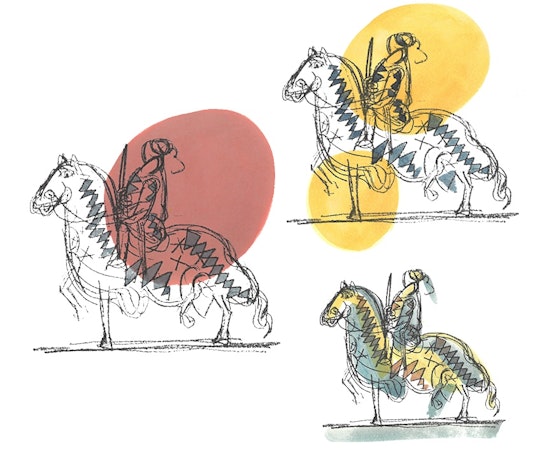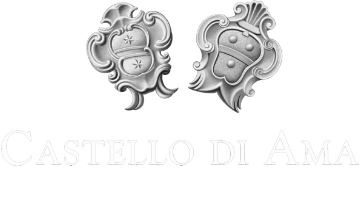Origin and identity
The founding of Castello di Ama dates back to 1976, when four families originally from Rome set out to restore a prestigious wine estate to the splendor it deserved. The estate, which originally consisted of 55 hectares and was located in the heart of Chianti Classico, was immediately enhanced through major investments in the vineyard, following the most up-to-date agronomic techniques of the time, and the construction of a new winery, equipped with steel tanks, temperature control and large work spaces.
With the infrastructure in place that could project Castello di Ama among the most advanced wineries in the area, the company recognized the need for a person who could take over the winemaking with personality and competence. So it was in 1982, with the arrival of Marco Pallanti, a young agronomist at the time, that the winery embarked on the decisive momentum in the pursuit of quality without compromise.
In the 1980s Castello di Ama helped consolidate the cru concept, producing the Chianti Classico selections: "Vigneto Bellavista", whose first vintage was in 1978; "Vigneto San Lorenzo", from 1982; "Vigneto La Casuccia", from 1985; and "Vigneto Bertinga", from 1988. The first years of experimentation eventually led to the exploration of non-traditional varieties that could further enhance the characteristics of Sangiovese: Merlot, initially overgrafted to a small parcel of Canaiolo and Malvasia Bianca, brought such astonishing qualitative results that it merited a label of its own, the one that would become "L' Apparita", one of the jewels of world enology.
The direction toward winemaking quality, sheltered from market trends, was then reinforced in its premises in 1988 with the entry of Lorenza Sebasti, daughter of one of the founding partners, and her rise to the role of CEO. The communion of purpose between Lorenza Sebasti and Marco Pallanti has led to total critical acclaim since the 1990s, placing Castello di Ama among the very first Chianti Classico estates and among the leading ones in Italy.
To date, Castello di Ama owns and manages about 75 hectares of vineyards and 40 hectares of olive groves, relying on the work of more than 60 people. The role of general manager and oenologist is held continuously by Marco Pallanti, who served, between 2006 and 2012, as President of the Chianti Classico Consortium, bringing the contribution of the creation of the 'Gran Selezione' category with the aim of highlighting the extraordinary quality and diversity of the region's wines.
The vineyards of Castello di Ama are located in the municipality of Gaiole in Chianti, under the homonymous Additional Geographical Unit (u.g.a.) of Chianti Classico, at an altitude ranging between 430 m and 520 m above sea level. The winery, throughout its history, has always chosen to own and invest in vineyards in the immediate vicinity of the winery's cellar, in order to bring to the winery grapes with the best quality and health status possible.
Over the years, with the consolidation of experience and the advancement of scientific knowledge, Castello di Ama has replanted almost the entirety of its hectares, finding the best standard in vineyards of medium density, at 5500 plants/ha, following the most advanced clonal selections of Sangiovese and other complementary varieties and modifying the orography through terracing to gain the best exposures.
In fact, the four valleys from which Castello di Ama wines come are within 1.5 km of the winemaking cellar. All production comes purely from the vineyards conducted by the winery under sustainable agriculture.
The average annual production is about 320,000 bottles, consisting mostly of wines under the Denominazione di Origine Controllata e Garantita "Chianti Classico."
"Surrounding the castle of Ama there are the most beautiful hills and valleys of all Chianti, cultivated to marvels with fertile soils of grains, olive trees and beautiful vineyards, well exposed, assolative, all kept excellently as gardens, with much population and houses scattered over the countryside; this part being the most fertile and renowned of Chianti followed thus toward the Castellana and toward the Senese."
Granduca Leopoldo di Toscana, Relazioni sul governo della Toscana, 1773

Since the winery's founding, the knight Guidoriccio da Fogliano as painted by Simone Martini has stood out on our wine labels, stylized and graphed by the painter Gian Carozzi (1920 - 2008).
"Guidoriccio da Fogliano at the taking of Montemassi" is a fresco located in Siena's Palazzo Pubblico, inside the Sala del Mappamondo, and is attributed to Simone Martini. It was painted around 1330-1336. The fresco depicts a Sienese condottiero, Guidoriccio da Fogliano, during the siege of Montemassi in 1328, and shows the knight, wearing armor and carrying a lance, as he surveys the surrounding battlefield.
